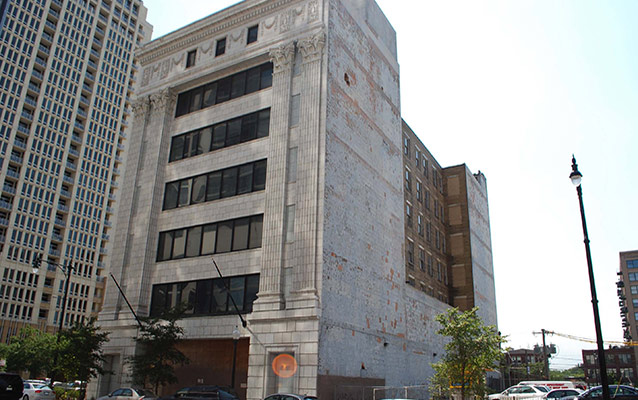Last updated: February 17, 2023
Place
Curtiss--Wright Aeronautical University Building

Photograph by Kelsey Shipton, Emily Ramsey courtesy of Illinois State Historic Preservation Office
Quick Facts
Location:
1338-1342 S. Michigan Ave., Chicago, Illinois
Significance:
African American History, Education
Designation:
Listed in the National Register - Reference number 13000827
OPEN TO PUBLIC:
No
The 1920s and 1930s were the height of the golden age of flight in America, marked by spectacular air shows, record-breaking flights, and larger-than-life aviators. Early milestones, such as the Wright brothers' first flight at Kitty Hawk in 1903 and Glenn Curtiss' flights for the Scientific American Trophy in 1908, 1909, and 1910, had occurred at remote sites scattered across the county. However, by the end of World War I, Chicago had successfully positioned itself as the epicenter for America's aviation activities.
In June of 1929, the Wright Aeronautical Corporation and the Curtiss Aeroplane and Motor Company merged to form the Curtiss-Wright Corporation. The merger united over a dozen aircraft manufacturing and distributing organizations, including the Curtiss Flying Service, and created an aviation superpower with assets of more than 70 million dollars. Local excitement surrounding the merger intensified in August when the Curtiss Flying Service announced the opening of an aeronautical university in downtown Chicago, which would provide academic and ground laboratory training to complement the flying instruction offered at the newly completed Curtiss-Reynolds Airport in Glenview. Although the economic crisis that would later become known as the Great Depression curbed some of the far-reaching plans of the Curtiss Flying Service, there was a widespread belief that the new field of aviation could transcend the immediate downturn.
The Aeronautical University at 1338-1342 South Michigan Avenue offered courses of study in aviation mechanics, aviation administration, and aviation welding in addition to three separate pilot courses. Lecture-style classes were supplemented with a good deal of hands-on training.
From the beginning, the Curtiss-Wright Aeronautical University promoted itself as an inclusive institution. The Chicago Daily Tribune, in the 1929 article announcing the opening of the school, took pains to emphasize that women were eligible to enroll in classes at the school, and that anyone over sixteen years of age with some grammar school education could take basic classes. Such open-mindedness did not initially extend to black Chicagoans. When the school first began to operate out of the building on South Michigan Avenue, it admitted only white students. By the early 1930s, however, the school would become the first accredited aviation school in the Midwest to admit black students and hire black instructors.
In 1930, two automotive mechanics, Cornelius Coffey and John C. Robinson, applied to the Curtiss-Wright Aeronautical University for admittance into the airplane mechanics course. Both men received acceptance letters, but when they arrived for their first class the school administrators refused to admit them because they were black. Coffey, encouraged by his employer to stand up to the school administrators, threatened to sue the school if he and Robinson were not allowed to attend classes. Superintendent L. M. Churbuck capitulated, and Coffey and Robinson became the first black students in the Midwest to be accepted into an accredited aviation school. Both men would eventually go on to become licensed pilots and airplane mechanics; Coffey had the distinction of being the first African American to hold both a pilots' and mechanics' license. They would also be the only black students of the Curtiss Wright Aeronautical University to attend classes alongside white students. Although Coffey and Robinson excelled in their courses, the Aeronautical University was unwilling to continue to accept black students on an integrated basis, most likely out of fear that white students would no longer want to attend. In a compromise of sorts, Churbuck agreed that if Coffey and Robinson could enroll twenty-five black students, the school would agree to admit and educate them as a separate class. In 1931, as part of their effort to stimulate interest in aviation activities among black Chicagoans, the two men formed the Challenger Air Pilots Association. By January of 1932, the two men had gathered together enough men and women under the auspices of the Challenger Association to form the Aeronautical University's first black class. Robinson and Coffey were hired as instructors at the school, and both would eventually teach not only black but white students as well.
